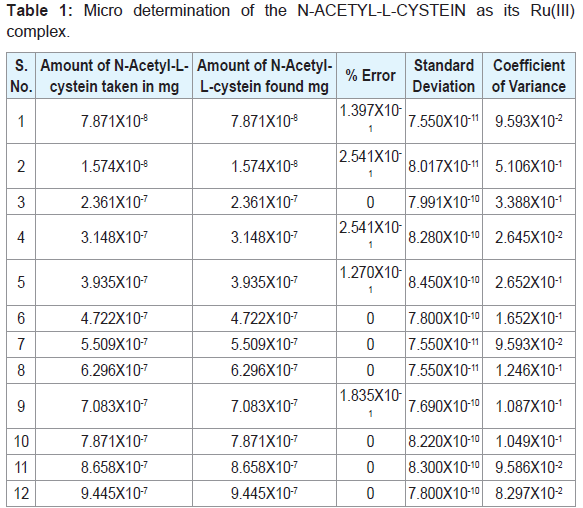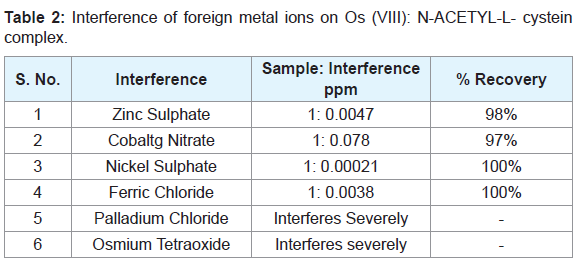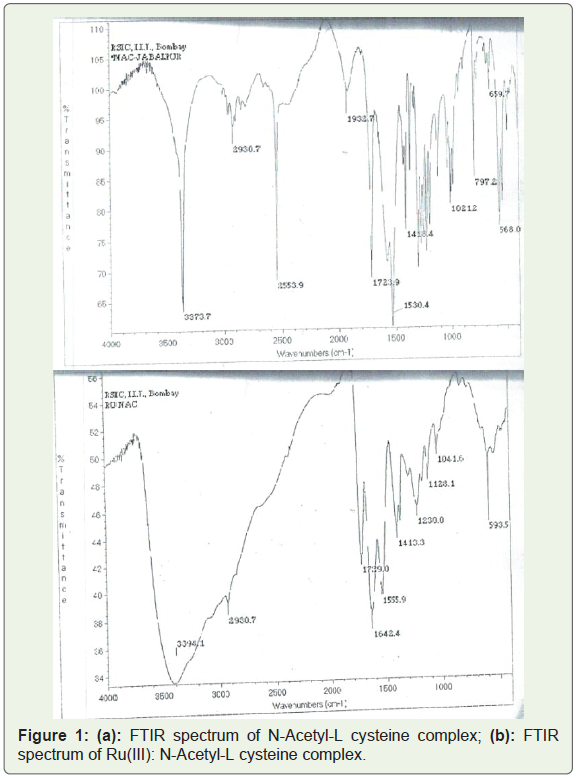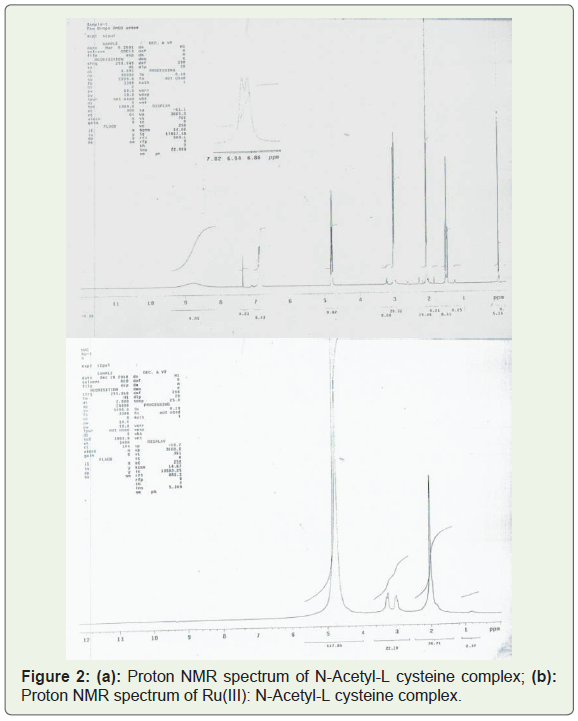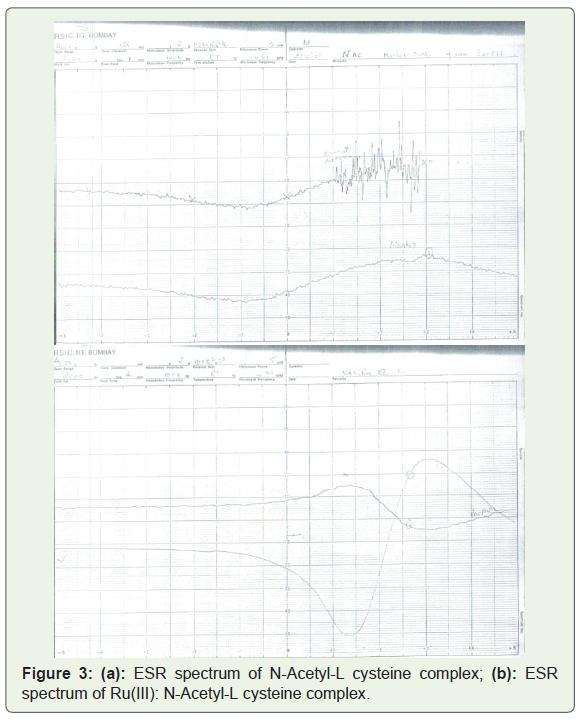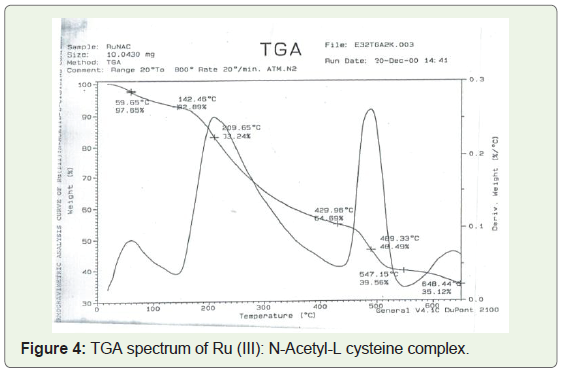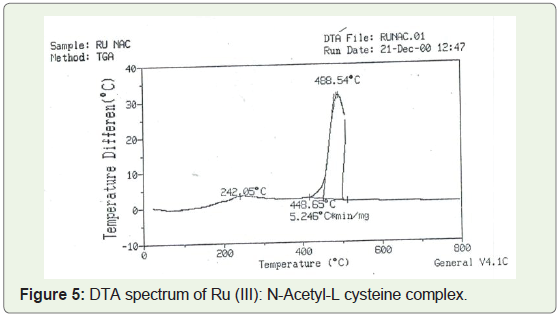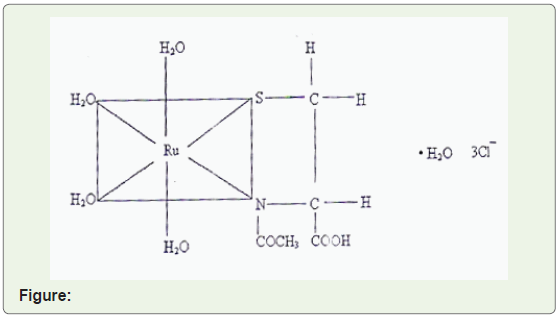Research Article
Medical Nutritional and Biochemical Role of N-Acetyl-L-Cysteine and its Spectrophotometric Determination by Complexion with RU (III) and Characterization by Elemental Analysis, FTIR, ESR, NMR, TGA, DTA Proposed Structure of the Complex
Sharma KP*
Department of Chemistry, Hawabagh Women’s College, India
Corresponding author: Sharma KP, Department of Chemistry, Hawabagh Women’s College, Jabalpur, Madhya Pradesh, India, E-mail: kavitapal360@gmail.com
Citation: Sharma KP. Medical Nutritional and Biochemical Role of N-Acetyl-L-Cysteine and its Spectrophotometric Determination by Complexion with RU (III) and Characterization by Elemental Analysis, FTIR, ESR, NMR, TGA, DTA Proposed Structure of the Complex. J Chem Applied Biochem. 2017;4(1): 122.
Copyright © 2017 Sharma KP. This is an open access article distributed under the Creative Commons Attribution License, which permits unrestricted use, distribution, and reproduction in any medium, provided the original work is properly cited.
Submission: 10/07/2017; Accepted: 22/08/2017; Published: 25/08/2017
Abstract
Micro determination of the antioxidant, anti-HIV drug N- Acetyl-L-Cysteine was achieved by its complexation with Ru(III) using spectrophotometry, Ru(III) form very light brown colour complex with N-Acetyl-L-Cysteine at rooms temperature max of the complex is 464 nm, ---= 5.62X103 L/mol/cm. Beer’s law range is 7.871 x 10-8 mg to 9.445x 10-7 mg, Job’s method of continuous and mole ration method confirms the metal to ligand ratio as 1:1. Effect of presence of foreign metal ions was also studied, and it was also studied and it was found that 1 ppm of N-Acetyl-L-Cysteine can bear 0.00047 ppm of zinc sulphate, 0.078 ppm of cobalt nitrate, 0.00021 ppm of Nickel sulphate, 0.0038ppm of ferric chloride and Os(VIII), Pd(III) interfere, Characterization of the complex was done by elemental analysis (CHN estimation) which confirms the metal to ligand ration as 1:1 FTIR spectrum of the complex ascertain the binding of sulphur atom and NH2 group. 1H NMR spectrum of the complex exhibit a disappearance of SH peak and NH peak hence confirming the binding of sulphur and nitrogen atom with Ru(III). Three ESR signals show paramagnetic nature of the complex. DTA, TGA confirms the presence of lattice and coordinated water molecules.
Keywords: FTIR; NMR; ESR; DSC; TGA; DTA
Introduction
N- Acetyl- L-Cysteine (NAC) is a biologically active substance with a mucolytic effect and it has been shown to be effective as an antidote for treatment of acetaminophen poisoning [1,2].
Sulfur-containing nutrients play several critical roles in the body including detoxification and protecting cells and cellular components against oxidative stress.
Sulfhydryl compounds, that are excellent radiation protectors, are also free radical scavengers peroxide decomposers, catalyst of sulfhydryl disulfide exchange and possibly can implement repair of damaged sites. These along with Vitamin E increase the limit of tolerance to selenium by the human body [3].
Nowadays, NAC is being ascribed with greater importance that even glutathione. It is produced in living organisms from the amino acid cysteine. Thus, NAC is natural sulphur containing amino acid derivative occurs in foods. It is a powerful antioxidant too [4,5]. These dual properties help repair oxidative damage in the body.
For example, by the Human Immunodeficiency Virus (HIV). It has been established that reduced intracellular glutathione in the direct and early consequence of retroviral infection [6].
Intracellular glutathione has a powerful influence on how well T and B-lymphocyte cells function [6,7]. In addition, intracellular glutathione availability affects the production of phagocytes (Macrophages, monocytes and neutrophils). T- Cell and B-Cell are lymphocytes. The phagocytes have the function of killing viruses, bacteria and fungi Free radicals can impair the immune system and NAC can protect against free radicals and may enhance the immune system [8-10].
NAC blocks the AIDS (HIV) virus production in vitro, by increasing glutathione levels in HIV infected cell [11-23]. Beside vitamin C reducing oxidized glutathione back to free reduced (active) glutathione, vitamin C and NAC had complementary actions to slow the replication of the AIDS virus.
Detoxification
These sulphur containing nutrients protect against toxins. NAC is particularly effective and NAC detoxifies several toxic agents including the heavy metals such as mercury, lead and cadmium [24-30], drugs including acetaminophen (eg. TylenoITM) [31-38], herbicides such as Paraquat [39], environmental pollutants such as carbon tetrachloride and urethane and microorganism including Aflatoxin and Escherichia coli [40-47].
NAC, cysteine and glutathione contain sulphur in the form of sulfhydryl groups. Sulfhydryl groups directly react with many poisons. Especially heavy metal such as lead, mercury and cadmium. They also offer second line and third line defenses in the liver and various individual cells. Sulfhydryl groups also help remove toxins indirectly via enzyme system called the P-450 system.
NAC also has a secondary role in detoxification since it helps produce optimal amounts of glutathione which also conjugates with most “foreign” compounds and excess oxidizers that enter cells. The harmful compounds that have been conjugated with glutathione then pass harmlessly out of the body through biliary system [30].
NAC is approved a drug for use prevent liver damage from over dosages of acetaminophen. Either NAC tablets of solutions are prescribed to protect against acetaminophen overdose.
The Lancer reports that NAC is also effective in reducing the toxic effect of carbon tetrachloride, chloroform and carbon monoxide [31]. NAC can also reduce the side effects of drugs such as doxorubicin, Ifosfamide, valproic acid and alcohol [31,37,38].
NAC and cancer
NAC protects against cancer by both of its roles as antioxidant and detoxifier [47-53].
NAC also reduces the toxic effects of some chemotherapy agent such as cisplatin and oxazaphosphorine based agents. In addition, it is useful in the prevention or reduction of the side effects of cyclophosphamide treatment in cancer patient [54,55].
Mucolytic
NAC has been used for about thirty years to break up mucus in persons having bronchopulmonary disease including chronic bronchitis, cystic fibrosis, asthma, sinusitis and pneumonia [56]. NAC helps reduce the viscosity of mucus so that it may be more easily coughed up [57]. NAC accomplishes this by converting the disulfide bonds of the mucoprotein into sulfhydryl bonds and clearing the mucoproteins into smaller molecules.
Several companies provide a 10 or 20 percent. NAC solutions a nebulizer spray (such as Bristol Laboratories: Mucomyst TM), while others such as Italy’s Zambon group provides NAC in tablet form. When a nutrient is topically applied or sprayed into the lungs, it can then be classified also as a drug because it does not enter into metabolism to nourish the body when it is administered in this way. [However, this is different from having a nutrients absorbed into the body by sublingual or nutrient absorbed into the body by sublingual or nasal membrane application which allows the nutrient to nourish the body].
Heart disease
A growing area of interest is a specific lipoprotein called Lp(a) as one of the two most reliable indicators of heart disease risk [58-62]. The other reliable indicator is the level of vitamin E in the blood [63]. Lp(a) is a much reliable indicator than blood cholesterol level, low density lipoprotein, high density lipoprotein or their ratios to each other.
Diets and drug designed to lower blood cholesterol level do not lower Lp(a) levels. Now recent research has found that NAC is most effective nutrient known to lower Lp(a) levels. NAC reduces Lp(a) by almost 70% [64-67]. Lp(a) consist of a LDL particle attached to the large lipoprotein apo(a) by one or more disulphide bonds. NAC breaks up the disulphide bonds converting each disulfide groups into two sulfhydryl groups, finally in two separate compounds.
NAC also inhibits heart damage by preventing TDL from being oxidized and by destroying free radicals produced after an infraction [68-71].
Antioxidant
NAC is the pre-catalyzed form of the simple amino acid and cysteine. N-acetyl-L-Cysteine is a powerful antioxidant and a premier antitoxin and immune support substance. Antioxidants neutralize free radicals, which are produced by normal metabolic activity. If free radicals are left unchecked they cause damage to cells and DNA and are considered by scientists to be a major factors in the aging process.
NAC IS currently the dietary supplement of choice for building up or conserving the body’s stores of glutathione, cysteine and other sulfhydryl antioxidant resources.
Being a powerful antioxidant nutrient, it has been of special interest to athletes for some time as heavy exercise increases oxidative damage in the body [72-74]. NAC maintains GSH and GSH-related antioxidant levels. The enzyme the body produces to fight free radicals. Body needs L-cysteine to produce GSH (Glutathione) a very powerful antioxidant.
As the body ages, its ability to digest and absorb protein become less and less over the year and the system becomes compromised. This directly results in shortage which in turn leads to any number of age related diseases, of the elderly people. Consequently, NAC has provided important benefit as an ‘elderly’ or age related disease antioxidant. It also works to maintain glutathione and related antioxidant levels that normally diseases with stress, injury, exercise or age, possessing antioxidant affects itself, NAC, also synergistically enhance vitamin C’s ability to support the immune system.
Sulphur as compared to the other second row elements of the periodic table, is much more versatile as reaction center than that of its first row counterparts oxygen. Oxygen containing compounds often alter the chemistry of the carbon atom to which oxygen is attached (Table 1).
Similar effects are found in organosulfur compounds, but owing to the high reactivity of the sulphur atom itself towards electrophilic, nucleophilic and even radical reagent, an overwhelming majority of reaction occurs directly at sulphur function.
Sulphur compounds are of prime importance in many industrial operations, in pharmaceutical industry and also in metabolic process.
Sulfhydryl group containing thiols are the fundamental building blocks for synthesizing other organosulfur compounds in plants and animals. Thiols are highly reactive and even small quantities play key role in biological processes.
Together with a number of other sulphur compounds, thiols occur as a small, though significant fraction of crude petroleum.
The dithiol HSCH2-CHSH-CH2OH known as BAL (British Anti_Lewisite) was developed as a protective agent against arsenical war gases and is an effective antidote for poisoning by arsenic, mercury and other heavy metal. Applications of disulphide includes polymerization catalyst, regulators in emulsions polymerization, dye intermediates, specific test reagents for thiol groups, floatation agent, softeners, vulcanization accelerators, plasticizers, insecticides, pesticides, fungicides and therapeutic drugs.
Several methods have been proposed for the determination of NAC, however, the procedure have only been developed for aqueous solutions of NAC in the absence of other compounds.
The methods described in the literature are generally based on the quantification of this thiol group and can be classified into three types:
1. Oxidation of the thiol group.
2. Formation of metal mercaptides.
3. Use of chromophoric reagents.
The oxidation of the third group can be performed with Iodine [75], chlorine and bromine [76], tetrathionate [77], or FeIII [78]. The metal mercaptides can be obtained by the titration of the thiol with HgII and AgI or PdII [79-82].
Direct UV spectrophotometry has also been used for the quantitative analysis of NAC solutions, but the method has been criticized because it suffers from numerous interferences and does not distinguish between NAC and inactive degradation product N, S-diacetylcysteine [83]. The official method for determining the NAC content in sterile solutions and inhalation solutions containing isoproterenol is based on the separation of NAC by High Performance Liquid Chromatography (HPLC) [84].
Other method are based on the reaction of NAC with 5,5’-dithiobis (2-nitrobenzoic acid) and hydroxylamine [85,86]. A fluorimetric method with monobromobimane (4-bromomethyl-2.3,5,- trimethyl-3a, 6a-diazapentalene -1, 6-dione has also been reported and the method has been applied to studies of the pharmacokinetic behavior of NAC by HPLC [87].
Primary amines react rapidly with O-Phthalaldehyde (OPA) in the presence of a thiol (usually 2-mercaptoethanol) to give 1-alkylthio-2alkylsubstituted isoindoles. The reaction has been used for the separation and fluorimetric detection of amino acid [88]. The reaction has also been applied to the fluorimetric determination of thiols with OPA and tryptophan as reagents [89-91]; however it does not include NAC. The procedure consists of the addition of 3.2 x 10-5 M OPA to a stirred mixture of 6.3 x 10-4 M tryptophan, boric acid borate buffer and the thiol in the concentration range 6.6 x 10-7-6.6 x 10-6 M.
NAC has been used in place of 2-mercaptoamino acid and antitumors with fluorimetric detection [92-96]. The reaction may also be applicable to the assay of NAC. This method was applied for the determination of NAC in several pharmaceutical formulations.
NAC has also been determined by chromatographic, gas chromatographic [97-101], spectrophotometric and spectrofluorimetric techniques [102-107]. It has also recently been determined by kinetic and Flow Injection (F1) methods [108-110]. Flow injection method based on the reaction of NAC with PdCl2 has been developed [111].
Numerous methods proposed for determination of N-acetyl-Lcysteine include 2-idoxybenzoate as a titrant for the determination but its end point is accomplished potentiometrically using platinum/calomel electrode combination [112]. HPLC determination using N [4-(5,6-dimethoxy-2-phthalamidyl] maleimide as precolumn fluorescence derivatization reagent [113]. This method along with flow injection method, require highly sensitive and costly instrument.
Capillary Zone electrophoresis with ultraviolet and fluorescence detection for the analysis of NAC also require costly instrument and is time consuming [114]. Several electrophoretic parameters have to be optimized such as buffer, pH, concentration, applied voltage, loading conditions, and column length and column diameter [115].
Polarographic method for determination of N-acetyl-L-cysteine was proposed which also requires adjustment of pulse.
O-Phthalaldehyde was used as precolumn derivatization for reversed phase HPLC and fluorometric determination but detection limit is l pmol [116].
Potentiometric method was proposed for determination of N-acetyl-cysteine based on its reduction action on iron (III) [117]. Linearity is attained in the range from 2.0 x 10-4 mol cm-3 mol cm-3.
Chemiluminescence - flow injection analysis of thiol containing drug. Procedures are based on the inhibition by the drug of the chemiluminescence generated in the copper catalyzed oxidation of luminal by H2O2 [118].
Cathode stripping voltammetry of N-acetyl-L-cysteine in presence of nickel ion and determination by means of mercury thiolate peak at (-0.4v) as NAC has no catalytic properties for the reduction of nickel [119]. So it is determined at pH 7 in phosphate- acetate buffer.
HPLC method developed for determination of NAC, on an ODS column using an isocratic mobile phase consisting of MeCN-MeOHsodium hexanesulfonic acid buffer (pH 2.9) at a flow rate of 1.0 ml/min. with UV detection at 220 nm [120]. Methionine as internal standard.
Experimental
Instruments
Toshniwal UV 2000 chemito spectrophotometric observations at Bose Memorial Research Lab, Govt. Science College, Jabalpur.
Elemental analysis was carried out at RSIC. Central Drug Research Institute, Lucknow.
The FTIR spectra were recorded in Nicolet FTIR spectrophotometer in the rage 4000-400 cm-1 using KBr pellets at RSIC, IIT, powai, Mumbai.
The ESR spectra were recorded in Varian ESR spectrometer in the scan range of 3000 gauss. Tetracyanoethylene was used as marker at RSIC, IIT Powai, Mumbai.
‘H HMR spectra were recorded in vrian-300 MHz spectrometer using deuterium oxide as solvent at RSIC, IIT, Powai, Mumbai.
Thermal Studies (Differential Thermal Analysis (DTA) and Thermo Gravimetric Analysis (TGA) were carried out in DuPont thermal analysis system under nitrogen atmosphere from 0 °C - 800 °C temperature range at a rate of 20 °C/Min a RSIC, IIT, Powai, Mumbai.
Reagents and sample
Ruthenium chloride: A standard stock solution of ruthenium chloride was prepared by dissolving 1.00 g of hydrated ruthenium (purris, Bombay) in 2M HCI acid and volume is made up to 1 liter. Standardization of ruthenium chloride was done spectrophotometrically by thiourea. Solutions of lower concentration were prepared by diluting aliquots of stock solution.
N-acetyl-L-cysteine: N-acetyl-L cysteine solution is prepared in double distilled water. NAC is completely soluble in distilled water. N-acetyl-L-cysteine is sigma product. The NAC s standardized isometrically using starch as indicator.
Preliminary studies: When ruthenium chloride solution is added to the solution of N-acetyl-L-cysteine at room temperature, a light yellow colored is formed. Absorption curve obtained for the complex has maximum absorbance at 464 nm.
Effect of pH: In acid medium pH ranging from 3-6.0, the absorbance remains unaffected but above this pH slight turbidity appears.
Effect of foreign metal ions: Effect of presence of different metal ions was studied. The results are summarized in Table 2.
Analysis
Procedure
To an aliquot containing 9.44 x 10-7 mg N-acetyl-cysteine and excess amount of Ru(III) was made up to 20 ml with water Allow to react the contents for a period of 30 min. Thereafter fill the reference cell with the reaction mixture and record the absorbance on the λmax 464 nm. The concentration of the N-Acetyl-L-Cysteine is found out from the Beer’s law graph by drawing a perpendicular from the point at which the absorbance values crosses it to the concentration axis.
Molar composition of complex: The composition of the complex was determined by Job’s method of continuous variation as modified by Vosburgh and mole ration method and was found to be 1:1 with Ru(III) : W-acetyl-L-cysteine.
Adherence to beer’s law
Beer’s law is obeyed over the range 7.87x10-8 mg to 9.445x10-7 mg mole extinction coefficient = 5.62x103 Lmol-1.
Results and Discussion
Micro determination of N-Acetyl-L-cysteine was performed spectrophotometrically by complexation with Ru(III) Ru(III) forms 1:1 complex with N-acetyl-L-cysteine at room temperature, the complex formed follow the Beer’s law in the range 7.871 x 10-8 to 9.445 x 10-7 .
Characterization of the complex formed between Ru(III): N-Acetyl-L-Cysteine was done by elemental analysis, FTIR, NMR, ESR and TGA.
Elemental Analysis: Reaction product (complex) of Ru(III): N-Acetyl-L-Cysteine is characterized by elemental analysis. Calculated results have been found in good agreement with the actually found experimentally. The results of elemental analysis are summarized in Table 3.
A perusal of these results confirms that M:L ration is 1:1. This has further been confirmed by Job’s method of continuous variance as well as mole ration method.
FTIR spectrum
FTIR spectrum of N-Acetyl-L-Cysteine and its Ru(III) complexrecorded in the range 4000-400 cm1 exhibit following bands (Figure 1).
A stretching band at 2553.9 cm-1 of pure N-Acetyl-L-Cysteine assigned to -SH stretching band and a band at 659 cm-1 which is assigned to SH bending, are completely disappeared in the corresponding FTIR spectrum of Ru(III) : N-Acetyl-L-cysteine complex confirming the involvement of sulfhydryl group in complex formation.
A small band at 568 cm-1 in the FTIR spectrum of N-Acetyl- Cysteine attributed to C-S stretch is shifted to 593.0 cm-1 in its complex owing to complexation of thiol group with ruthenium.
In the FTIR spectrum of N-Acetyl-L-Cysteine there is sharp intensity band at 3373 cm-1 assigned to NH2 stretching frequency, is shifted to 3394 cm-1 in its Ru(III) complex with reduced intensity and broadening of band takes place which confirms the involvement of NH group in bonding with Ru(III).
A prominent stretching band at 1340 cm-1 assigned to C-N stretch in the FTIR spectrum of pure N-Acetyl-L-Cysteine is almost diminished in the spectrum of Ru(III) complex, confirming the involvement of amino group in complexation.
Stretching band at 1530 cm-1 is attributed to asymmetric stretching and 1418 band attributed to symmetric stretching of carboxylic group in the FTIR spectrum of NAC are at 155.9 cm-1, 1413.3 cm-1 in Ru(III) complex but the intensity of the band is reduced.
Medium intensity bands at 1021.2 cm-1, 1129 cm-1, 1723 cm-1, 2930.7 cm-1, exhibited by N-Acetyl-L-Cysteine molecules are assigned to stretching mode of -CO, bending mode of -OH group of carboxylic group v-OH mode of carboxylic group, these bands are shifted to 1041 cm-1, 1128 cm-1, 1728 cm-1, 2930 cm-1 which is an indication of presence of uncoordinated-COOH group.
NAC as its Ru(III) complex exhibits stretching bands at 1642 cm-1 which are assigned to -OH and banding mode of coordinated water molecules.
1H HMR spectra
1H NMR spectrum: The proton NMR spectrum of Ru(III) : N-Acetyl-L-Cysteine complex shows the following features:
1. In the proton NMR spectrum of N-Acetyl-L-cysteine in D2O, the signal at signal at 4.60 ppm is attributed to CH, quaterete 3.00 ppm attributed CH2 group have downfield to 4.77 ppm and 3.29 ppm respectively.
2. Chemical shift at 1.2 ppm and 1.4 ppm of N-Acetyl-L-Cysteine are attributed to SH and NH proton respectively. In the Ruthenium: N-Acetyl-L-Cysteine complex the signal at 1.2 ppm and 1.4 ppm is disappeared confirming the involvement of SH group and NH group in complex atom (Figure 2).
ESR studies
ESR spectrum of Ru complex of N-Acetyl-L-Cysteine was recorded at room temperature on microwave frequency of 9.1 GHz. It exhibit following features:
1. The +3 oxidation state of Ru has d5 configuration and it forms low spin hexa-coordinated complexes with one unpaired electron. Therefore all the complexes of Ru(III) exhibit ESR spectrum owing to the presence of unpaired electron and having I=7/2 for Ru.
2. Ru complex of N-Acetyl-L-cysteine given ESR signal, which confirms the fact that reduction of Ru(III) to Ru(II) by sulfhydryl group of N-Acetyl-L-cysteine has taken place (Figure 3).
Thermal studies (TGA and DTA)
Thermogravimetric analysis of Ru (III): N-Acetyl-L-cysteine complex were carried out under nitrogen atmosphere at a rate of 20 °C/ min from 0 °C to 800 °C.
The TGA curve of the complex shows the loss in weight at 59.65 °C which is due to loss of lattice water molecule, because such water molecules has been found to be lost in complex below 100 °C
At 142.46 °C (weight loss 5 209.65 °C 429, 96 °C, 489 33 °C (weight loss is 9%) which is attributed to loss of coordinated water molecules (Figure 4).
At 429.96 °C there is 28% weight loss. This weight loss correspond to elimination of N-Acetyl-L-Cysteine moiety from the remaining complex, at 489.33 °C 8% weight loss takes place which is due to decomposition of remaining N-Acetyl-L-Cysteine moiety to give chemical carbon, hydrogen, nitrogen. At 648 °C the weight loss is from 39% to 35.12% show the breakage of Ru and sulphur bond.
Differential Thermal Analysis (DTA): DTA curve of the complex between Ru(III) : N-Acetyl-L-Cysteine exhibits following endotherm/ exothermal changes.
Below 100 °C small endotherm is observed, confirms the presence of lattice water molecule.
From 100 °C to 242 °C small exotherm shows the removal of coordinated water molecule from the complex.
A broad exotherm at 488.54 °C is associated with breaking of bond between Ru(III) and N-Acetyl-l-L-Cysteine and also decomposition of N-Acetyl-L-cysteine moiety starts.
On the basis of all the instrumental methods of characterization the structure of the complex is:-
Proposed structure of Ru(III) : N-Acetyl-L-Cysteine complex
Acknowledgment
Govt. Science College, Jabalpur, RSIC, IIT, powai, Mumbai.
References
- Aylward M, Maddock J, Dewland P (1980) Clinical evaluation of acetylcysteine in the treatment of patients with chronic obstructive bronchitis: A balanced double blind trial with placebo control. Eur J Respir Dis 61: 81-89.
- Prescott LF, Illingworth RN, Critchley JA, Stewart MJ, Adam RD, et al. (1979) Intravenous N-acetylcystine: the treatment of choice for paracetamol poisoning. Br Med J 2: 1097-1100.
- Passwater, Richard A, Welker, Paul A (1971) Human Aging Research: Part Two Amer Lab 3: 21-26.
- Knight KR, MacPhadyen K, Lepore DA, Kuwata N, Eadie PA, et al. (1991) Enhancement of ischaemic rabbit skin flap survival with the antioxidant and free-radical scavenger N-acetylcysteine. ClinSci (Lond) 81: 31-36.
- De Flora S, Izzotti A, D’Agostini F, Cesarone CF (1991) Antioxidant activity and other mechanisms of thiols involved in chemoprevention of mutation and cancer. Am J Med 91: 122S-130S.
- Eck HP, Stahl-Hennig C, Hunsmann G, Dröge W (1991) Metabolic disorder as early consequence of simian immunodeficiency virus infection in rhesus macaques. Lancet 338: 346-347.
- Wu J, Levy EM, Black PH (1989) 2-Mercaptoethanol and n-acetylcysteine enhance T cell colony formation in AIDS and ARC. ClinExpImmunol 77: 7-10.
- Carson DA, Seto S, Wasson DB (1986) Lymphocyte dysfunction after DNA damage by toxic oxygen species. A model of immunodeficiency. J Exp Med 163: 746-51.
- El-Hag A,Lipsky PE, Bennett M, Clark RA (1986) Immunomodulation by neutrophil myeloperoxidase and hydrogen peroxide: differential susceptibility of human lymphocyte functions. J Immunol 136: 3420-3426.
- Stagnaro R, Pierri I, Piovano P, Baracco F, De Palma M, et al. (1987) Thiol containing antioxidant drugs and the human immune system. Bull EurPhysiopatholRespir 23: 303-307.
- (1991) Suppression of cytokine-induced human immunodeficiency Virus (HIV) expression by N-acetylcysteine (NAC), glutathione (GHS) and Glutathione monoester (GSE) Kinter Audrey L., et al. 75th Annual Meeting of the Federation of American Socieities for Experimental Biology, Atlantha, Georgia. J.FASEB 5: 1265.
- Kalebic T, Kinter A, Poli G, Anderson ME, Meister A, et al. (1991) Suppression of human immunodeficiency virus expression in chronically infected monocytic cells by glutathione, glutathione ester, and N-acetylcysteine.Proc NatlAcadSci U S A 88: 986-990.
- (1991) Thiol-based compounds may limit AIDS progression: CDC AIDs Weekly pp: 3.
- Roederer M, Raju PA, Staal FJ, Herzenberg LA, Herzenberg LA (1991) N-acetylcysteine inhibits latent HIV expression in chronically infected cells. AIDS Res Hum Retroviruses 7: 563-567.
- Roederer M, Staal FJ, Raju PA, Ela SW, Herzenberg LA, et al. (1990) Cytokine-stimulated human immunodeficiency virus replication is inhibited by N-acetyl-L-cysteine. Proc NatlAcadSci U S A 87: 4884-4888.
- Staal FJ, Roederer M, Herzenberg LA, Herzenberg LA (1990) Intracellular thiols regulate activation of nuclear factor kappa B and transcription of human immunodeficiency virus.Proc NatlAcadSci U S A 87: 9943-9947.
- Turner VF (1990) Reducing agents and AIDS--why are we waiting? Med J Aust 153: 502.
- Wu J, Levy EM, Black PH (1989) 2-Mercaptoethanol and n-acetylcysteine enhance T cell colony formation in AIDS and ARC. Clin Exp Immunol 77: 7-10.
- (1989) AIDS Drug therapy, Acetylcysteine research. Cooper, Mile CDC AIDS weekly pp: 4.
- Vallis KA (1991) Glutathione deficiency and radiosensitivity in AIDS patients. Lancet 337: 918-919.
- Harakeh S, Jariwalla RJ (1991) Comparative study of the anti-HIV activities of ascorbate and thiol-containing reducing agents in chronically HIV-infected cells. Am J Clin Nutr 54: S1231-S1235.
- Mihm S, Ennen J, Pessara U, Kurth R, Dröge W (1991) Inhibition of HIV-1 replication and NF-kappa B activity by cysteine and cysteine derivatives. AIDS 5: 497-503.
- Mihm S, Droge W (1990) Intracellular glutathione level Controls DNA- binding Activity of NF kappa B- like proteins. Int Conf AIDS 6: 159.
- Lorber A, Baumgartner WA, Bovy RA, Chang CC, Hollcraft R (1973) Clinical application for heavy metal-complexing potential of N-acetylcysteine. J Clin Pharmacol 13: 332-336.
- Henderson P, Hale TW, Shum S, Habersang RW (1985) N-Acetylcysteine therapy of acute heavy metal poisoning in mice. Vet Hum Toxicol 27: 522-525.
- Lund ME, Banner W Jr, Clarkson TW, Berlin M (1984) Treatment of acute methylmercury ingestion by hemodialysis with N-acetylcysteine (Mucomyst) infusion and 2,3-dimercaptopropane sulfonate. J Toxicol Clin Toxicol 22: 31-49.
- Livardjani F, Ledig M, Kopp P, Dahlet M, Leroy M, et al. (1991) Lung and blood superoxide dismutase activity in mercury vapor exposed rats: effect of N-acetylcysteine treatment. Toxicology 66: 289-295.
- Girardi G, Elias MM. Effectiveness of N-acetylcysteine in protecting against mercuric chloride-induced nephrotoxicity. Toxicology 67: 155-164.
- Banner W Jr, Koch M, Capin DM, Hopf SB, Chang S, et al. (1986) Experimental chelation therapy in chromium, lead, and boron intoxication with N-acetylcysteine and other compounds. Toxicol Appl Pharmacol 83: 142-147.
- Ketterer B, Coles B, Meyer DJ (1983) The role of glutathione in detoxication. Environ Health Perspect 49: 59-69.
- (1991) Acetylcysteine. Lancet 337: 1069-1070.
- Lauterburg BH, Corcoran GB, Mitchell JR (1983) Mechanism of action of N-acetylcysteine in the protection against the hepatotoxicity of acetaminophen in rats in vivo. J Clin Invest 71: 980-991.
- Corcoran GB, Wong BK (1986) Role of glutathione in prevention of acetaminophen-induced hepatotoxicity by N-acetyl-L-cysteine in vivo: studies with N-acetyl-D-cysteine in mice. J Pharmacol Exp Ther 238: 54-61.
- Burgunder JM, Varriale A, Lauterburg BH (1989) Effect of N-acetylcysteine on plasma cysteine and glutathione following paracetamol administration. Eur J Clin Pharmacol 36: 127-131.
- Prescott LF, Donovan JW, Jarvie DR, Proudfoot AT (1989) The disposition and kinetics of intravenous N-acetylcysteine in patients with paracetamol overdosage. Eur J Clin Pharmacol 37: 501-506.
- Harrison PM, Wendon JA, Gimson AE, Alexander GJ, Williams R (1991) Improvement by acetylcysteine of hemodynamics and oxygen transport in fulminant hepatic failure. N Engl J Med 324: 1852-1857.
- Kassahun K, Farrell K, Abbott F (1991) Identification and characterization of the glutathione and N-acetylcysteine conjugates of (E)-2-propyl-2,4-pentadienoic acid, a toxic metabolite of valproic acid, in rats and humans. Drug Metab Dispos 19: 525-535.
- Lopez RA, Tornwall MS, Henagan JM, Smith GS, Miller TA (1991) N-acetyl-cysteine: protective agent or promoter of gastric damage? Proc Soc Exp Biol Med 197: 273-278.
- Hoffer E (1991) N-acetycysteine improves the survival rate of paraquat poisoned rats: Elucidation of its mode of action. Rev Respir Dis 143: 731.
- Howard RJ, Blake DR, Pall H, Williams A, Green ID (1987) Allopurinol/N-acetylcysteine for carbon monoxide poisoning. Lancet 2: 628-629.
- Ruprah M, Mant TG, Flanagan RJ (1985) Acute carbon tetrachloride poisoning in 19 patients: implications for diagnosis and treatment. Lancet 1: 1027-1029.
- Mathieson PW, Williams G, MacSweeney JE (1985) Survival after massive ingestion of carbon tetrachloride treated by intravenous infusion of acetylcysteine. Hum Toxicol 4: 627-631.
- De Flora S, Astengo M, Serra D, Bennicelli C (1986) Inhibition of urethan-induced lung tumors in mice by dietary N-acetylcysteine. Cancer Lett 32: 235-241.
- Mráz J, Turecek F (1987) Identification of N-acetyl-S-(N-methylcarbamoyl)cysteine, a human metabolite of N,N-dimethylformamide and N-methylformamide. J Chromatogr 414: 399-404.
- Du Y, Boczkowaski J, Aubier M (1991) N-acetylcysteine prevents diaphragmatic contractile alterations induced by Escherichia- coli endotoxemia in rats. Rev Respir Dis 143: 560.
- Raj HG, Lotlikar PD (1984) Urinary excretion of thiol conjugates of aflatoxin B1 in rats and hamsters. Cancer Lett 22: 125-133.
- Sheety TK, Francis AR, Bhattacharya RK (1989) Modifying role of dietary factors on the mutagenicity of aflatoxin B1: in vitro effect of sulphur-containing amino acids. Mutat Res 222: 403-407.
- De Flora S, Rossi GA, De Flora A (1986) Metabolic, desmutagenic and anticarcinogenic effects of N-acetylcysteine. Respiration 50: 43-49.
- De Flora, Silvio, et al. (1984) In vitro effects of N-acetycysteine on the mutagenicity of direct acting compounds and procarcinogens. Carcinogenesis 5: 505-510.
- De Flora S, Bennicelli C, Camoirano A, Serra D, Romano M, et al. (1985) In vivo effects of N-acetylcysteine on glutathione metabolism and on the biotransformation of carcinogenic and/or mutagenic compounds. Carcinogenesis 6: 1735-1745.
- De Flora S (1984) Detoxification of genotoxic compounds as a threshold mechanism limiting their carcinogenicity. Toxicol Pathol 12: 337-343.
- Trizna Z, Schantz SP, Hsu TC (1991) Effects of N-acetyl-L-cysteine and ascorbic acid on mutagen-induced chromosomal sensitivity in patients with head and neck cancers. Am J Surg 162: 294-298.
- Rotstein JB, Slaga TJ (1988) Effect of exogenous glutathione on tumor progression in the murine skin multistage carcinogenesis model. Carcinogenesis 9: 1547-1551.
- Andersen M, Kristjansen PEG, Hansen HH (1990) Second line chemotherapy in small cell lung cancer. Cancer Trat Rev 17: 427-436.
- Martinez E, Domingo P (1991) N-acetylcysteine as chemoprotectant in cancer chemotherapy. Lancet 338: 249.
- (1980) Long term oral acetylcysteine in chronic bronchitis: A double blind controlled study. Multicenter Study Group Er J Respir Dis 61: 93.
- Sheffner AL (1963) The reduction in vitro in viscosity of mucoprotein solutions by a new mucolytic agent, N-acetyl-L-cysteine. Ann N Y Acad Sci 106: 298-310.
- Rhoads GG, Dahlen G, Berg K, Morton NE, Dannenberg AL (1986) Lp(a) lipoprotein as a risk factor for myocardial infarction. JAMA 256: 2540-2544.
- Durrington PN, Ishola M, Hunt L, Arrol S, Bhatnagar D (1988) Apolipoproteins (a), AI, and B and parental history in men with early onset ischaemic heart disease. Lancet 1: 1070-1073.
- Hajjar KA, Gavish D, Breslow JL, Nachman RL (1989) Lipoprotein(a) modulation of endothelial cell surface fibrinolysis and its potential role in atherosclerosis. Nature 339: 303-305.
- Lipoprotein(a) Editorial Laancet 337-397-398.
- Rees A (1991) Lipoprotein (a): a possible link between lipoprotein metabolism and thrombosis. Br Heart J 65: 2-3.
- Gey KF, Puska P, Jordan P, Moser UK (1991) Inverse correlation between plasma vitamin E and mortality from ischemic heart disease in cross-cultural epidemiology. Am J Clin Nutr 53: S326-S334.
- Gavish D, Breslow JL (1991) Lipoprotein(a) reduction by N-acetylcysteine. Lancet 337: 203-204.
- Stalenhoef AFH, et al. (1991) N- acetylcysteine and lipoprotein. The Lancet 337: 203-204.
- Scanu AM (1991) N-acetylcysteine and immunoreactivity of lipoprotein(a). Lancet 337: 1159.
- Scanu AM, et al. (1991) Thiols and cysteine- containing compounds attenuate the immunoreactivity of Lp(a). Arterioscl Thromb 11: 148.
- Ceconi C, Curello S, Cargnoni A, Ferrari R, AlbertiniA, et al. (1988) The role of glutathione status in the protection against ischaemic and reperfusion damage: effects of N-acetyl cysteine. J Mol Cell Cardiol 20: 5-13.
- Tang LD, Sun JZ, Wu K, Sun CP, Tang ZM (1991) Beneficial effects of N-acetylcysteine and cysteine in stunned myocardium in perfused rat heart. Br J Pharmacol 102: 601-606.
- Hansen PR (1991) Lipoprotein(a) reduction by N-acetylcysteine. Lancet 337: 672-673.
- Boesgaard S, Aldershvile J, Pedersen F, Pietersen A, Madsen JK, et al. (1991) Continuous oral N-acetylcysteine treatment and development of nitrate tolerance in patients with stable angina pectoris. J Cardiovasc Pharmacol 17: 889-893.
- Duthie GG, Robertson JD, Maughan RJ, Morrice PC (1990) Blood antioxidant status and erythrocyte lipid peroxidation following distance running. Arch Biochem Biophys 282: 78-83.
- Meydani M, et al. (1990) Protective effect of vitamin e on exercise induced oxidative damage in young and elderly subjects. International Society for Free Radical Research, 5th Biennial Mtg. Pasade4na CA 14-20.
- Novelli GP, Bracciotti G, Falsini S (1990) Spin-trappers and vitamin E prolong endurance to muscle fatigue in mice. Free Radic Biol Med 8: 9-13.
- Motonaka J, Ikeda S, Tanaka N (1982) Potentiometric titratlons of N-acetyl-L-cysteine, glutathione, and D-penicillamine with an iodide-selective electrode. Bunseki Kagaku 31: 669-674.
- Nikolić K, Velasević K, Jovanović T (1987) Chlorocoulometric determination of N-acetyl-L-cysteine. Pharmazie 42: 134.
- Verma K (1979) Titrimetric determination of thiols: Tetrathionate, iron(III), cystine and hexacyanoferrate(III) as thiol reagents. Talanta 26: 277-282.
- Raggi MA, Cavrini V, Di Pietra AM (1982) Colorimetric determination of acetylcysteine, penicillamine, and mercaptopropionylglycine in pharmaceutical dosage forms. J Pharm Sci 71: 1384-1386.
- Washington DC (1975) “The National Formulary XIV” American Pharmaceutical Association pp: 22.
- Rockville MD (1979) The United States Pharmacopeia XX; US Pharmacopeial Convention pp: 17.
- Vogel E (1986) Pharm Praax 41: 257.
- Jovanovic T, Stankovic B, Stefanovic A (1987) [Determination of N-acetyl-L-cysteine by potentiometric titration]. Pharmazie 42: 136-137.
- Bequette RJ (1975) Letter: analysis of acetylcysteine. Am J Hosp Pharm 32: 460.
- Rockville MD (1975) “The United States Pharmacopeia XXI” US Pharmacopeial Convention pp: 19.
- Murty BS, Kapoor JN, Kim MW (1977) Estimation of acetylcysteine and its preparations. Am J Hosp Pharm 34: 305-306.
- Valerio R, Ceschel GC (1966) [Colorimetric determination of N-acetylcysteine]. Boll Chim Farm 105: 675-681.
- García Alvarez-Coque MC, Medina Hernández MJ, Villanueva Camañas RM, Mongay Fernández C (1989) Formation and instability of o-phthalaldehyde derivatives of amino acids. Anal Biochem 178: 1-7.
- Nakamura H, Tamura Z (1981) Anal Chem 53: 2190.
- Nakamura H, Tamura Z (1982) Anal Chem 54: 1951.
- Nakamura H, Matsumoto A, Tamura Z (1983) On the Stability of Isoindole-Type Fluorophores Derived from O-Phthalaldehyde, Primary Amino Compounds and Thiols. Anal Lett 15: 1393-1410.
- Metz PA, Gehas J, Spriggle JE, Veening H (1985) J Chromatogr 330-307.
- Aswad DW (1984) Determination of D- and L-aspartate in amino acid mixtures by high-performance liquid chromatography after derivatization with a chiral adduct of o-phthaldialdehyde. Anal Biochem 137: 405-409.
- Usher JJ, Lewis M, Hughes DW (1985) Determination by high-performance liquid chromatography of some compounds involved in the biosynthesis of penicillin and cephalosporin. Anal Biochem 149: 105-110.
- Nimura N, Krumen K (1986) J Chromatogr 352: 169.
- Buck RH, Krummen K (1987) High-performance liquid chromatographic determination of enantiomeric amino acids and amino alcohols after derivatization with o-phthaldialdehyde and various chiral mercaptans. Application to peptide hydrolysates. J Chromatogr 387: 255-265.
- Fujiwara M, Ishida Y, Nimura N, Toyama A, Kinoshita T (1987) Postcolumn fluorometric detection system for liquid chromatographic analysis of amino and imino acids using o-phthalaldehyde/N-acetyl-L-cysteine reagent. Anal Biochem 166: 72-78.
- Shimada K, Tanaka M, Mambera, Anal Chim, (1983) Acta 147: 375.
- Toyo’oka T, Imai K (1983) High-performance liquid chromatography and fluorometric detection of biologically important thiols, derivatized with ammonium 7-fluorobenzo-2-oxa-1,3-diazole-4-sulphonate (SBD-F). J Chromatogr 282: 495-500.
- Lewis PA, Woodward AJ, Maddock J (1984) High-performance liquid chromatographic assay for N-acetylcysteine in plasma and urine. J Pharm Sci 73: 996-998.
- Holdiness MR, Morgan L, Gillen L, Harrison EJ, Chromatogr (1986) Biomed Appl 55: 99.
- Johansson M, Westerlund D (1987) Determination of N-acetylcysteine, intact and oxidized, in plasma by column liquid chromatography and post-column derivatization. J Chromatogr 385: 343-356.
- Raggi MA, Cavrini V, Di Pietra AM (1982) Colorimetric determination of acetylcysteine, penicillamine, and mercaptopropionylglycine in pharmaceutical dosage forms. J Pharm Sci 71: 1384-1386.
- Talley JR, Magarian RA, Sommers EB (1973) Feasibility of unit dose packaging of medications for inhalation therapy. Am J Hosp Pharm 30: 526-530.
- Murty BS, Kapoor JN, Kim MW (1977) Estimation of acetylcysteine and its preparations. Am J Hosp Pharm 34: 305-306.
- Groszkowski S, Ochocki Z Farm (1980) Pl 36: 273.
- Jovanovic TS, Stankovic BS (1989) Use of palladium(II) chloride as a colour-forming reagent for the determination of N-acetyl-L-cysteine in water and Fluimukan injections. Analyst 114: 401-403.
- Imai K, Toyo’oka T, Watanabe Y (1983) A novel fluorogenic reagent for thiols: ammonium 7-fluorobenzo-2-oxa-1,3-diazole-4-sulfonate. Anal Biochem 128: 471-473.
- Garcia MS, Sanchez- Pedreno C, Albero MI (1990) Inhibition of the palladium-catalysed reaction between cobalt(III)-ethylenediaminetetraacetate and hypophosphite. Kinetic determination of cysteine, N-acetylcysteine and cystine. Analyst 115: 989-992.
- Vinas P, Cordoba MH, Pedreno CS (1990) Catalytic titration of N-penicillamine, N-acetylcysteine, cysteine and 2-mercaptopropionylglycine. Analyst 115: 757-760.
- Vinas P, Sanchez J, Hernandez M, Quim (1990) Anal 9: 205.
- Concepcion Sanchez-Pedreno, M Isabel Albero, M Soledad Garcia, Vicente Rodenas (1997) Analyst 117.
- Rizk MS, Belal F, Eid MM (1993) 2-Iodoxybenzoate as a titrant for the determination of some pharmaceutically-important thiol compounds. Acta Pharm Hung 63: 13-18.
- Tsuruta Yasuto, Moritani Kazuhiro, Date Yuuko, Kohashi Kazuya (1992) N-4-(5,6-Dimethoxy-2-phtha1imidy1)pheny1]ma1eimide [as Precolumn Fluorescence Derivatization Reagent for Thiols Anal Sci 8: 393-394.
- Pedreño CS, Albero I, Garcia S, Rodenas V (1992) Determination of N-acetylcysteine in pharmaceutical samples by flow injection. Analyst 117: 925-928.
- Belal F, Metwally ME, Moustafa MA (1991) Polarographic determination of N-acetyl-L-cysteine in pharmaceutical preparations. J Pharm Belg 46: 320-324.
- Wu YQ (1993) [Determination of acrylamide metabolite, mercapturic acid by high-performance liquid chromatography]. Zhonghua Yu Fang Yi Xue Za Zhi 27: 221-223.
- Komljenovic Josipa, Radic Njegomir (1993) Acta Pharm 43: 99-108.
- Vinas P, Garcia IL, Gil JAM (1993) Determination of thiol-containing drugs by Chemiluminescence-flow injection analysis. J Pharm Biomed Anal 11: 15-20.
- Banica FG, Fogg AG, Ion A, Moreira JC (1996) Cathodic stripping voltammetry of sulphur-containing amino acids and peptides in the presence of nickel ion. Catalytic and inhibiting effects. Anal Lett 29: 1415-1429.
- Tasi FY, Chen CJ, Chien CS (1995) Determination of the cysteine derivatives N-acetylcysteine, S-carboxymethylcysteine and methylcysteine in pharmaceuticals by high-performance liquid chromatography. J Chromatogr A 697: 309-315.

